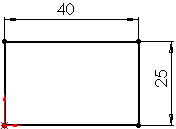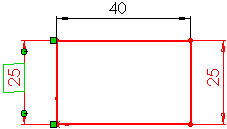Sketch States
Sketches are generally in one of the following states:
Under defined
Fully defined
Over defined
The sketch status appears in the window
status bar.
Colors indicate the state of individual sketch entities.
|
Under defined.
As you begin a sketch, you can drag the entities to change their
shape or position. In this rectangle, the black left and bottom lines
are fixed to the origin, but you can drag the top and right lines. Blue
indicates that the entity is not fixed, and light blue indicates that
the entity is selected.
To add relations to a sketch, click
Add Relations on the Dimensions/Relations
toolbar. |

|
|
Fully defined.
Adding dimensions to the top and right fixes the sizes of all the
sides of the rectangle because of the implied equal relations between
top and bottom and the two sides. The rectangle itself is fixed to the
origin. All the entities turn black, indicating that the rectangle is
fully defined.
You can add relations (parallel, perpendicular, equal length, and so
on) to a fully defined sketch. The sketch tolerates these logically redundant
relations. |

|
|
Over defined. Redundant dimensions
over define a sketch. The red rectangle is over defined. When you insert
dimensions, they are assumed to be driving
dimensions. To have two dimensions driving the same geometry is invalid.
A dialog box appears allowing you to designate the redundant dimension
as driven.
You can view and delete relations. Click Display/Delete
Relations on the Dimensions/Relations toolbar.
It is possible to create geometry that is unsolvable or invalid. The
items that prevent the solution are displayed in pink (unsolvable) or
yellow (invalid). Sketches with these types of geometry are labeled No Solution Found or Invalid
Solution Found. |

|
Dimensions and relations are two types of constraints. You define sketches
with either type, or both.
Although you can create features using sketches that are not fully defined,
it is a good idea to fully define sketches for production models. Sketches
are parametric, and if they are fully defined, changes are predictable.
However, sketches in drawings, although
they follow the same conventions as sketches in parts, do not need to
be fully defined since they are not the basis of features.